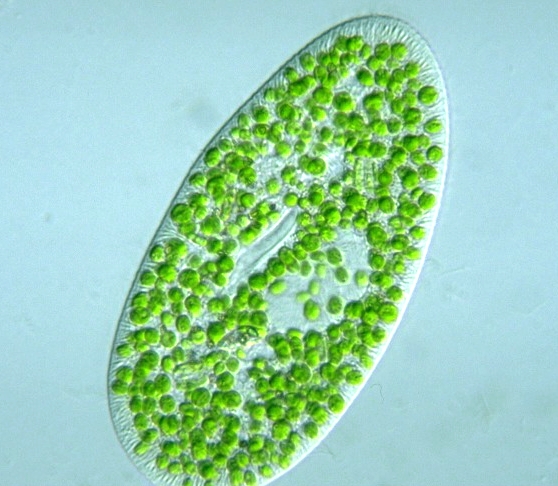Introduction:
Paramecium bursaria,
found in almost all kinds of freshwater habitats, is a species of ciliate
protozoan that has a mutualistic symbiotic relationship with green alga called Chlorella. Whereas natural populations
of P. bursaria are known, their Chorella-bearing counterparts are
commoner in natural habitats. The algae live inside the paramecium in its
cytoplasm and provide it with food, while the paramecium provides the alga with
movement and protection [1]. P. bursaria
is 80-150 μm long, with a wide oral groove, two contractile vacuoles, and a
single micronucleus as well as a single macronucleus [1]. P. bursaria is the only species of paramecium that forms symbiotic
relationships with algae, and is often used in biology classrooms as examples
of protozoans, and as examples of symbiosis.
Green algae may be unicellular, multicellular, colonial, or
coenocytic. They have membrane-bound chloroplasts and nuclei. Most green algae are aquatic; specifically, Chlorella is found commonly in
freshwater where populations of P.
bursaria are also found. Chlorella,
a genus of unicellular green alga with about 100 species, is grown like yeast
in bioreactors, where it has a very rapid life history [2]. It may be taken in
the form of tablets or capsules, or added to foods such as pasta or cookies [2].
Taken in any form, it is said improve the nutritional quality of a daily diet
[2]. According to the Taiwan Chlorella Manufacturing Company, the increase in
processed and refined foods in the diet of modern man make Chlorella an important food supplement for anyone interested in
better health [2].
Figure 1. The cytoplasm of Paramecium bursaria filled with green Chlorella algae.
http://protist.i.hosei.ac.jp/pdb/images/ciliophora/paramecium/bursaria/sample_4.jpg
Description of the
Relationship:
The symbiosis between the ciliate Paramecium bursaria and representatives of the green algae Chorella is a good example of a facultative
mutualistic interaction. Among ciliate Paramecium
species, only P. bursaria can
maintain endosymbiotic algae in the cytoplasm [3]. In fact, algae-free P. bursaria cells hardly ever exist in
natural environments. Typically, P.
bursaria harbor several hundred symbiotic algae in their cytoplasm. The algae live inside the cytoplasm of P. bursaria and provide it with food, while in return, P. bursaria provides the algae with movement and protection (as depicted in the video below).
Video 1. Mutualistic relationship between Paramecium bursaria and green algae Chlorella.
http://www.youtube.com/watch?v=zH7WEgVjZZg&feature=fvsr
A paper published by Sommaruga and Sommtag discussed the “classical”
view of mutual benefits between P.
bursaria and Chlorella as the
efficient transfer of inorganic elements from the paramecium to the
algae and of photosynthate leaking from the endosymbionts to the host [3]. Chlorella excrete large concentrations of carbohydrates used by P. bursaria to maintain its metabolism, allowing P. bursaria to become partially or totally independent of external food supply [3]. In return, the P. bursaria provides respiratory CO2 that can be photosynthetically fixed by Chlorella [3].
Cost/Benefit
Analysis:
As mentioned briefly above, the mutualistic relationship between P.
bursaria and Chlorella is pretty straightforward. Serving as the host, Paramecium
bursaria can supply algal cells with nitrogen components and CO2
[4]. Furthermore, when within the host, the host protects algae from infection
of the Chlorella virus [4]. Also,
algal carbon fixation is enhanced in the host. On the other hand, the algae can
supply the host with a photosynthetic product, maltose [4]. The algae in the
host show a higher rate of photosynthetic oxygen production than in the
isolated stated, thereby guaranteeing an oxygen supply for the host in return
[4]. It has been proven that algae-bearing P.
bursaria can grow better than non-algae-bearing cells. The algae have a
photo-protective role for the host [4]. Furthermore, photosynthetic products of
symbiotic Chlorella are related
closely to the expression of circadian rhythms in host P. bursaria [4]. Timing of cell divisions of both the algae and the
host cells is well coordinated [4].
References:
[1] “Ciliates Paramecium Bursaria.” (2006) Niles Biological,
Inc. Sacramento, CA. Retrieved 13 April 2012 from <http://www.nilesbio.com/prod138.html>.
[2] Guiry, Michael. (2011) “Chlorophyta: Green Algae.” University
of Ireland ISRG (Irish Seaweed Research Group). Galway, Ireland. Retrieved 13
April 2012 from <http://www.seaweed.ie/algae/chlorophyta.html>.
[3] Sonntag B, Sommaruga R. (2009) Photobiological Aspects
of the Mutualistic Association Between Paramecium
bursaria and Chlorella. Freshwat
Biol 52 : 1476 – 1485. Retrieved 13 April 2012 from <http://homepage.uibk.ac.at/~c71986/Sommaruga%20and%20Sonntag%202009.pdf>.
[4] Fujishima M, Kodama Y. (2009) Infection of Paramecium bursaria by Symbiotic Chlorella Species. Endosymbionts in
Paramecium VIII, 252 p. Retrieved 13 April 2012 from
<http://www.springer.com/978-3-540-92676-4>.

ReplyDeletePacking and unpacking is part and parcel of moving goods. Through our vendors you could get professional packing for the wide range of items for your home and office.
شركة نقل اثاث من جدة الى عمان
شركة نقل عفش من جدة الى دبي
شركة نقل عفش من الدمام الى القطيف
LINK1
ReplyDeleteLINK2
LINK3
LINK4
LINK5